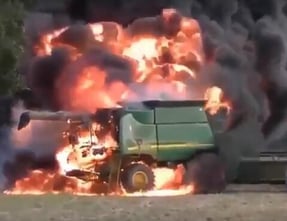
|
Let’s keep combine fire prevention as one of our priorities as we are abnormally dry in many crop-producing areas. Combine fires cost growers millions in damages each harvest and in a very dry year like this, the potential is even higher. |
| Combine Fire Prevention |
Preventing combine fires starts with understanding how they start. Any fire needs four elements to burn: oxygen, fuel, an ignition or heat source and a chemical chain reaction. Without each of these 4 components, fire cannot begin or continue. Oxygen is in the air all around, but you can limit the fuel and heat available to potential fires by keeping your machinery clean, and in good repair.
| Maintenance and Cleaning |
Maintenance and cleaning are incredibly important components of fire prevention, particularly the engine area. Maintenance helps minimize the likelihood of mechanical or electrical failure, and consistently cleaning off harvest debris and crop residue reduces the potential fuel for a fire.
Some components of the combine’s electrical systems are at higher risk of overheating, particularly parts like starters and heating and cooling systems that draw a heavy electrical load. Fuses that blow regularly should be considered an important warning sign that the circuit is overheating somewhere.
Harvest season brings a unique combination of risk factors that increases the risk of combine fires, said Bill Field, professor of agricultural and biological engineering. Dust kicked up during field operations and dry plant material from crops can clog or wrap around machinery, causing it to overheat. Other common hazards are electrical malfunctions, sparks from hitting rocks, loose or slipping belts and leaks in fuel or hydraulic lines.
Worn bearings or seals and blocked exhaust systems can cause overheating and sparks. Inspecting equipment at the end of the day can help prevent overheated components from catching fire during the night, Field said, and a hand-held thermal camera can help detect hot areas before they ignite.
| Having Spotters |
Insulated cabs may prevent operators from noticing smoke or flames until it’s too late. Combine fires can start without warning and quickly grow out of control. I strongly suggest sharing fire responsibilities with other operators. Make it part of the grain cart operator and truck drivers’ responsibility to monitor the combine while in the field. Don’t assume people know that or that it’s obvious to do so. Make it clear to all workers during a meeting that the combine operator cannot see what’s happening behind the cab and that it requires the eyes of everyone working around the combine to monitor combine for a fire. It should be a requirement...not a suggestion.
| Call 911 First |
Operators should always have a cell phone or two-way radio with them in the cab. If a fire does break out, the first step is to call 911 before anything else. You may want to act immediately and try to extinguish it, but getting the fire department dispatched as soon as possible is important. Fire is unpredictable, and even if it appears to be a small, manageable fire, you may not be able to extinguish it. In that situation, having the fire department present will help prevent the fire from spreading further on your property or your neighbor's property. I have a neighbor who lost the combine but was able to save the head because the fire department got there.
| Personal Safety Comes First |
If you are driving and suspect a fire, pull away from the crops and shut down the engine before you inspect. Check for your cell phone or communication device, grab the fire extinguisher, and get out. Call for help. Make sure you and all your employees understand that tractor and combine fires burn very hot, and can be deadly; a machine can be replaced and is not worth a life. People, unlike equipment, are irreplaceable.
| Fire Preparedness Checklist |
Make sure you’re prepared to protect your property as well as the health and safety of your employees this season by taking the following steps.
- Ensure staff is trained in proper equipment cleaning and maintenance practices, and make sure these are kept up throughout the entire season.
- Equip each combine with two fully charged, UL-approved ABC fire extinguishers.
- Equip all trucks and tractors with additional fire extinguishers. There are cases where it took several extra extinguishers from other equipment to help get the combine fire out.
- Have all extinguishers professionally inspected each year.
- Ensure all staff is familiar with proper fire extinguisher operation. Because each extinguisher lasts only seconds, it’s critical that employees are able to use the extinguisher properly from the moment it becomes necessary.
- Have a tractor and disc nearby while the combine is in operation. This will provide an opportunity to create a fire break to prevent spread across the entire field.
- Equip each combine with a shovel. In case the fire extinguishers fail to completely put out a fire, you can try to smother it with soil.
Nobody ever thinks that they'll be the farmer who watches helplessly as their combine burns. But clearly, it happens. This fall, take the necessary preparations to mitigate combine fires and make sure everyone Gets Home Safe.
I wish you nothing but safety for you, your family, and your operation this fall season.
Marty Huseman



